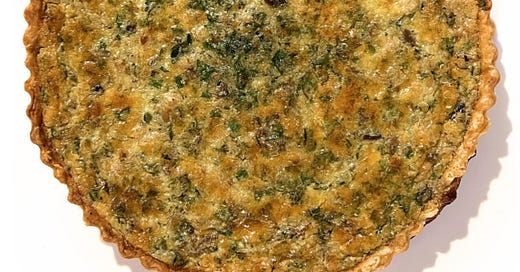THE MUSHROOM-SHALLOT-PARSLEY trio, cooked in butter, is duxelles in culinary language. It goes back four centuries in France, maybe further; sometimes scallions take the place of shallots. Probably La Varenne gave the name in the mid-1600s, when he was chief cook for the Marquis d’Uxelles in Burgundy. The combination appears in La Varenne’s Le Cuisinier François — a highly influential, modernizing cookbook that in its first 50 years went through more than 50 editions — although nothing in it is called duxelles.
In making the tart, don’t substitute big, bland, boring supermarket shallots for true shallots. The ideal is the arced French gray shallot (its skin is fawn gray), which, sadly, is in season only from mid-summer to December, when it begins to sprout. Not far behind in flavor is the round Dutch Red or Dutch White shallot, which lasts without sprouting until April. Now, in early June, my Dutch Red all have green sprouts inside, but most are very usable. Real shallots are much smaller than the ones now sold in North American supermarkets. Not quite trusting my memory about the former size, I checked US cookbooks from the time. Jacques Pépin was clear in 1987 in The Art of Cooking: 10 or 12 sliced shallots made 1 cup. If you don’t have real shallots, which can be hard to find, you’re better off for any purpose with either scallions or regular onions. For duxelles, Escoffier mixed shallots with onion.





